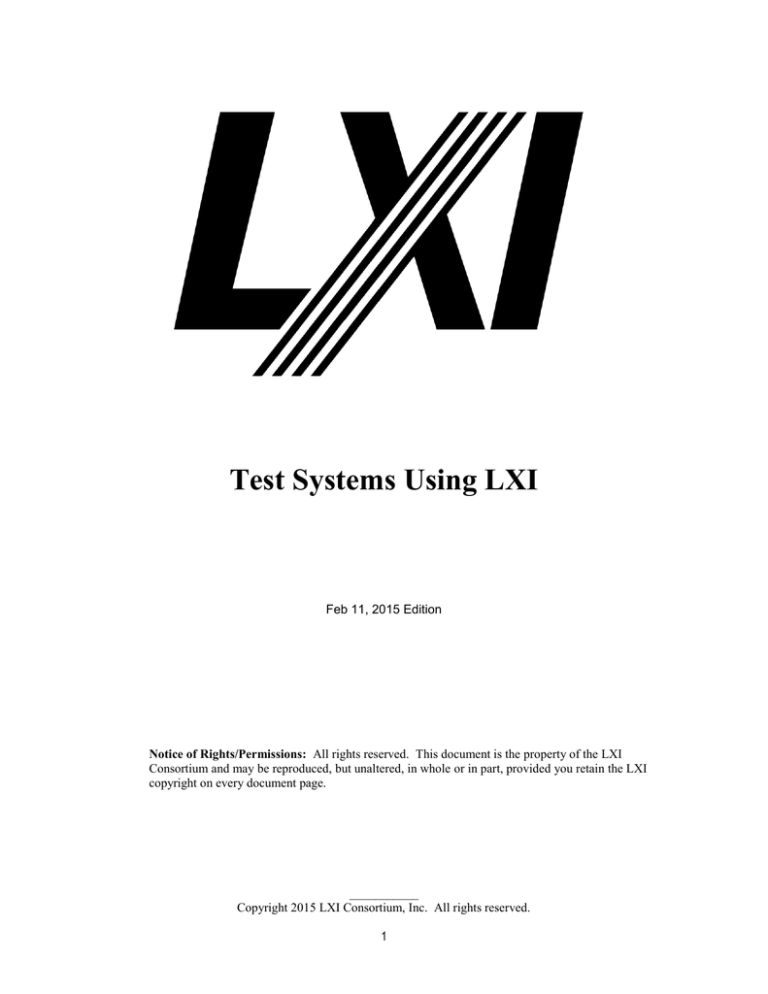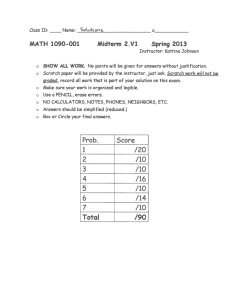
Test Systems Using LXI
Feb 11, 2015 Edition
Notice of Rights/Permissions: All rights reserved. This document is the property of the LXI
Consortium and may be reproduced, but unaltered, in whole or in part, provided you retain the LXI
copyright on every document page.
___________
Copyright 2015 LXI Consortium, Inc. All rights reserved.
1
Table of Contents
TEST SYSTEMS USING LXI..................................................................................................................... 1
1
INTRODUCTION ................................................................................................................................ 3
2
TEST SYSTEM COMPONENTS AND ARCHITECTURE ............................................................ 4
2.1
2.2
2.3
3
TYPICAL TEST SYSTEM CONFIGURATION ........................................................................................ 4
TEST SYSTEM SETUP INSIGHTS ........................................................................................................ 6
BUILT-IN WEB SERVER FOR CONTROL-MONITORING ..................................................................... 8
TEST SYSTEM APPLICATIONS ..................................................................................................... 9
3.1
3.2
PXIE MODULE TESTER.................................................................................................................... 9
SATELLITE SYSTEM TESTING .........................................................................................................11
___________
Copyright 2015 LXI Consortium, Inc. All rights reserved.
2
1 Introduction
LXI Devices (LAN eXtensions for Instrumentation) are LAN-equipped instruments that conform to a
comprehensive set of rules detailed in the LXI Standard (www.lxistandard.org). Major Electronic Test
Equipment Manufacturers and Technical Consultants formed the LXI Consortium in 2004, and about 40
companies currently participate and maintain that standard. LXI provides the basis by which test systems
built from multiple vendors provide a common interface and experience.
LXI brings LAN into the test system and provides a wide range of flexibility to the test system engineer. In
particular, LXI Devices benefit from these major LAN features:
The ubiquitous nature of LAN
Its high performance data transfers
Low cost, readily available infrastructure
Flexibility for wired or wireless communication
Local and Remote (synchronized) access
Abundance of multiple protocols for varied functionality
Ability to embed Web servers within each instrument
The current number of LXI conformant products surpassed 2600 in June 2014, and there 50 broad
categories with many specialized products within those categories:
AC/DC Power Supplies
Electronic Load
LXI Event Detector
Power Meter
Solar Array Simulator
Amplifier
EMI Receiver
LXI Trigger
Power Supply Monitors
Sound and Vibration
Attenuation Control Units
Frequency Counter
LXI-PXI Controller
Scanning/Measuring System
Source Measure Unit
Audio Analyzer
Function / AWG
Mezzanine Carrier
SI - Downconverter
Source/Measure Switch
Baseband Generator
Function Card Carrier
Microwave Tuner
SI - Function / AWG
Spectrum Analyzer
Capacitance Meter
Impedance Analyzer
Multifunction Mainframes
SI - IF Digitizer
Switch
Data Acquisition
Interface Module
Multiple App Platform
SI - Upconverter
System Source Meter
Digitizer
JTAG/Boundary Scan
Network Analyzer
Signal Analyzer
System Switch / DMM
DMM
LCR Meter
Optical Power Meter
Signal Generators
Thermocouple Instrument
Drawer Fixture
LXI Bridge
Oscilloscopes
Signal Source Analyzer
Wireless Comm Tester
Test systems for virtually every application draw from this broad range of product categories, which means
that test systems built completely with LXI is a very real solution.
The focus of this paper is on illustrating the typical test system components and then presenting application
summaries of real-life test systems consisting of solely of LXI products and ones consisting of a hybrid of
LXI and other interfaces.
The LXI Consortium has written other documents to help test system developers: LXI Primer, LXI Getting
Started Guide, Building LXI-based Test Systems, Introducing LXI to Your Network Administrator, and
Maximizing Performance of LXI-Based Test Systems located on the LXI Consortium Website at
GuidesForUsingLXI. Please refer to these documents for detailed information about LXI, how to connect
multiple LXI Devices into a Test System, how LXI Devices behave on the LAN, how LXI can improve
overall performance, and the importance of working with your Network Administrator to meet test system
and company LAN requirements.
___________
Copyright 2015 LXI Consortium, Inc. All rights reserved.
3
2 Test System Components and Architecture
The architecture of a test system involves the interconnection of computer, measurement, and stimulus
devices, and it includes the interconnection of signals between these devices. Test system integration of
varied instrumentation requires early planning to achieve desired measurement, performance, and ease of
test program development. This section will identify the varied instrumentation solutions often used in test
systems, which forms the basis for understanding real-world test systems.
2.1
Typical Test System Configuration
A typical test system configuration provides matrix, general purpose, multiplexing, and even RF and
microwave switching to connect between the instruments and the Device-Under-Test (DUT). Such a
system may use instruments mounted in a rack, each with their own LXI conformant LAN communication
interface, display, and power supply. The system may also be composed of VXI, PXI, AXIe, or proprietary
mainframes, with instruments and switches residing on modules plugged into one or more mainframe slots
and a single communication interface to the computer. Many such mainframe products are available with
an LXI conformant LAN interface, as can be seen in the figure below.
With 50 product categories and over 2600 LXI products, one can expect test systems built solely using
LXI. However, some test systems use a hybrid approach, mixing GPIB, PXI, VXI, USB, etc., due to
specialized needs or due to legacy instruments without LAN interfaces. The Test System Applications
section of this document will illustrate such examples.
General Purpose Test System
The Interface illustrated in the figure above can be singular or multiple interfaces to communicate with the
various instruments making up the test system. The figure below illustrates the commands or interface
control messages propagate from the computer to the various instruments, and results are returned.
___________
Copyright 2015 LXI Consortium, Inc. All rights reserved.
4
Computer Controls Instruments and Receives Results
When LXI conformant devices make up the test system, the interface is the computer’s built-in LAN, and
the computer connects to a multi-port Switch to each of the LXI devices. This solution is inexpensive and
reliable. In most test systems using LAN, there would be a second LAN interface. One LAN interface
gives remote access of the computer from Test Developers, and the other interface isolates the LXI devices
from the corporate LAN.
Isolating Test System from Corporate LAN
The test system computer is located on the corporate LAN, which permits backup, sharing of test data,
remote access for development, and security control. The LXI devices are isolated from LAN traffic and
from un-authorized access during testing.
Building LXI-Based Test Systems, found at Guides for Using LXI, illustrates this and other configurations.
___________
Copyright 2015 LXI Consortium, Inc. All rights reserved.
5
2.2
Test System Setup Insights
Instrument I/O control is usually provided by an I/O Library installed on the computer. The two most
popular I/O Librations come from Keysight Technologies (formally Agilent) and National Instruments.
The LXI Consortium provides an LXI Discovery Tool to search for LXI devices, but the I/O Library
software typically provides this service and then provides easy access using VISA to access
instrumentation and control.
Since LXI devices all behave in the same manner when connecting them to LAN, it is easy to find them
using one of these tools. Once found, each has a Web page for identification of capabilities and another for
re-configuring the device, as illustrated below:
LXI Device Information and Configuration
___________
Copyright 2015 LXI Consortium, Inc. All rights reserved.
6
The test system configuration below would typically be set up to use a DHCP server to assign an IP address
to the test system computer, but the isolated LAN would select static private IP addresses for each of the
LXI devices, such as 169.154.10.1, 169.254.10.2, etc.
Test System IP Address Configuration
Test developers can access the test system computer via IP address or Host Name and can remote login to
the computer for test development, and one developer typically has access at a time.
___________
Copyright 2015 LXI Consortium, Inc. All rights reserved.
7
2.3
Built-In Web Server For Control-Monitoring
Almost all LXI devices provide another Web page or pages for controlling and monitoring the device. This
is invaluable to the test developer, since he is often sitting in his cubicle and not in front of the test system.
The Web page provides a soft front panel, a visual representation of the front panel, but it can also be a
window-oriented interface showing the complete configuration of the device. With LAN, you can have
multiple Web pages up on different devices or to a single device for viewing, as illustrated below.
Various examples of LXI Device Web Page Control and Monitoring
Test system developers who have used LXI devices rave about the Web pages provided by these devices.
With these pages, the test developer can step through his program and verify the device is properly
configured – correct channels closed, correct range of DMM, etc. With LXI devices, they always provide
distributed intelligence, which means you can observe operations while the computer test program is
running.
These insights and benefits of LXI become evident when walking through various real-world test systems
found in the next section. Refer to Guides for Using LXI for more information on first-time use of LXI,
building test systems, improving performance with LXI, and working with Network Administrators.
___________
Copyright 2015 LXI Consortium, Inc. All rights reserved.
8
3 Test System Applications
This section provides examples of real-world test systems using LXI devices. A common theme for all
examples is the benefit of remote access of instruments via Web pages for configuration and monitoring.
3.1
PXIe Module Tester
This test system has a wide variety of instrumentation used to test various PXIe modules. The PXIe
modules operate from DC to multi-gigahertz and must have each of their key specifications verified during
production. This requires precision switching and precision instrumentation from DC to multi-gigahertz.
Accuracy of a PXIe module requires the measurement or stimulus instruments have greater accuracy. This
often dictates stand-alone box products with lots of space for isolation of signals and their own power
generation. This particular system also has electronic loads for testing module power supplies, which
requires significant power dissipation and dictates a stand-alone solution. An additional requirement for
this test system included visibility of measurements on the Scope, Spectrum Analyzer, DMM, Counter, and
Power Meter. These are important troubleshooting helps for the test operator when failures occur.
The PXIe modules tested include both analog and digital and providing both input capture and output
waveforms. High-frequency digital signals require Jitter, Skew, and power testing, requiring signal
analyzers like oscilloscope, frequency counter, spectrum analyzer, and power meter. High frequency signal
generators provide precision differential and single ended signals for input capture testing. A function
generator provides low frequency and DC signals for testing level
comparators on trigger circuits, and a 6.5 digit or better DMM provides DC
voltage, current, and resistance measurements for calibration and
verification.
The test system utilizes an embedded computer in the PXIe mainframe.
This gives direct control of the PXIe modules using the PXIe IVI Driver.
Each instrument connects to a multiport LAN Switch, which then connects
to one of two LAN ports on the embedded computer. The other LAN port
connects to the corporate LAN giving access to the test developers.
Test developers remote login into the embedded computer and develop
their code using Microsoft Visual Studio and C#. All the instruments
provide IVI Drivers; however, for this particular system, the developers
utilized leveraged code from previous test systems and developed using the
SCPI language for programming.
Web page support using LXI devices was an absolute must for this test
system. The production team built two of these test systems, where one
located in an environmental lab and the other in a test lab, 120 yards apart
from each other. The test developers programmed the devices from their
cubicles, about mid-way between the two systems. Remote login gave the
developer easy access to the Visual Studio environment and desktop of the
computer. Web page access for each instrument from the embedded
computer gave the developer visibility of important images such as switch
positions, oscilloscope, and the spectrum analyzer. Working directly in
front of the test system was only necessary until verifying wiring
connections.
The figure below gives an image of the typical test developer remote
desktop for the embedded computer. As you can see in the figure, switch
settings in graphical format along with a representation of the oscilloscope
___________
Copyright 2015 LXI Consortium, Inc. All rights reserved.
9
captured signal are visible after having reached a breakpoint in the in the test program
Desktop screen capture of embedded computer
For this test system, communicating with the instruments over LAN was easy, and the use of LAN cables
instead of bulky cables found when using GPIB provided more space in the back of the cabinet. Initial
trouble shooting of wiring was particularly easy since the Web page for the Switch products allowed
closing and opening of multiplexers, general purpose, RF and uWave switches. This allowed manual
connection between the DUT and the various instruments. Since the instruments all had Front Panel
keyboards, developers could just manually configure each instrument when standing in front of the test
system. However, the Web pages for each instrument also provide full manual control of the device.
The following are key points made by test developers of this test system:
The test system is about 100 yards from my desk. It is also located in a noisy and somewhat
chilly climate-controlled Test Lab, and the test station environment does not provide a desk
and monitors for test code development near the system. Remote access is critical.
I need to be able to run and troubleshoot test programs on both remote systems quickly.
Two instruments were GPIB only – DMM and Electronic load. The Pulse Generator had
GPIB and LAN, but was not LXI conformant. Those three instruments were the most
difficult to use, since I had to rely upon interrogating them with interactive SCPI or monitor
the front panel interface to understand it they were properly configured.
For this particular test system, unless there is a need to modify connections, cycle power, or to install
another DUT for testing, virtually all test development takes place in the comfort of the test engineer’s
cubicle. Productivity is very high, and when running tests that last for hours or days, the test developer can
even monitor activity remotely from home via a VPN connection with the company network.
___________
Copyright 2015 LXI Consortium, Inc. All rights reserved.
10
3.2
Satellite System Testing
Satellites are involved in a wide range of applications including scientific research, weather prediction,
navigation, and military/aerospace. The greatest numbers of satellites that orbit the earth today are used for
communications, enabling people across the globe to communicate with one another. In fact, more than
half of the satellites in space are used for telecommunications. Beyond telecommunications, satellite
communications are intrinsically tied to almost every aspect of our daily lives whether we realize it or not.
LXI is particularly favored by the aerospace/defense industry where strict adherence to standards and
compliance is a necessity. All LXI products are certified compliant with the LXI standard, ensuring test
engineers that a combination of LXI products will integrate well together and that there is a consistent user
experience between products.
By standardizing and extending the LAN to instrumentation support, LXI simplifies the use of Ethernet for
test systems, providing a low-cost, cross-platform computer interface that can be controlled at any distance.
In this case, the phase of the transmission coefficient cannot be measured directly because the input and the
output signals have different frequencies. Moreover, the phase of the output signal is influenced not only by
the DUT, but also by the frequency and phase drift of its LO. Additionally, in the case where input and
output of the transmission system are located far apart, the group delay and phase are very difficult to
measure.
The two-tone method1 overcomes these problems. This method stimulates the DUT with a two-tone signal,
whereby the network analyzer measures the phase difference between the two carriers, both at the input and
the output of the DUT. From the resulting phase differences and the carrier frequency offset, the analyzer
calculates the group delay. As a result, the influence of one or more inaccessible LOs of the transmission
system is eliminated.
It also is possible to measure group delay on a transmission system by means of two LXI-based network
analyzers, one at the transmitting end and the other at the receiving end, that communicate with one another
using LAN messages. The LXI network analyzers are connected to one another via a LAN router with an
integrated DHCP server that assigns the IP addresses to the devices. Alternatively, the devices can use
fixed IP addresses.
The figure below shows the test setup where one LXI network analyzer acts as a master, the other one as a
slave. The master controls the slave via a LAN/WAN connection and processes and displays the results.
___________
Copyright 2015 LXI Consortium, Inc. All rights reserved.
11
Synchronization with IEEE 1588
The LXI clock synchronization extended function inherits IEEE 1588-2008 Precision Time Protocol used
to synchronize real-time clocks with sub-microsecond accuracy in devices of a networked distributed
system. This allows common timer events to be tied to absolute times for very precise triggering and
synchronization and enables the correlation between instruments to aid monitoring and debugging. In the
two-tone measurement example of the figure below, LXI clock synchronization enables the LXI network
analyzers to be synchronized with one another as well as with their PC controller.
All LXI instruments are required to provide a browser-based web interface to be compliant with the LXI
standard. Each device incorporates a standard set of web pages that offers useful information about the
instrument and allows you to configure the LAN interface. Unlike traditional GPIB or other modular test
systems that require the user to be nearby to monitor and control the system, LXI enables complete control
over the test system from anywhere in the world, significantly lowering operational and maintenance costs.
You can review and modify settings, examine acquired data, and operate the instrument from an intuitive
graphical user interface that significantly improves user experience and simplifies the basic tasks of
instrument control and interactive operation.
___________
Copyright 2015 LXI Consortium, Inc. All rights reserved.
12







